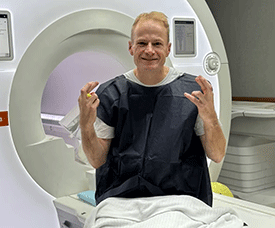 |
| Professor Scolyer says the latest MRI showed no recurrence 10 months since the glioblastoma was initially detected. |
Australian of the Year Richard Scolyer ‘blown away’ by success of radical new brain cancer treatment
(ABC News) -- World-first clinical trials of a groundbreaking treatment for aggressive brain tumours are likely to begin soon following “fantastic” results in the high-profile case of Australian of the Year, Professor Richard Scolyer.
Professor Scolyer, 57, was diagnosed with glioblastoma IDH wild-type in early June last year and became “patient zero” in a pioneering immunotherapy approach that has produced remarkable results: the tumour has not come back after 10 months.
“I’m blown away,” Professor Scolyer tells Australian Story. “This is not what I expected. The average time to recurrence for the nasty type of brain cancer I’ve got is six months. So, to be out this far is amazing. Amazing.”
Now, work is underway developing protocols for the start of clinical trials. If the results of those trials are strong, it could shake-up the current treatment regimen of surgery, chemotherapy and radiation that has not changed in 19 years.
“Hopefully, it’ll transform into improved outcomes, not just for me, but for all brain cancer patients,” Professor Scolyer says.
Professor Scolyer, a world-leading melanoma pathologist, shares the title of Australian of the Year with his colleague, medical oncologist Professor Georgina Long, for their life-saving work in the treatment of melanoma.
The duo are co-directors of Melanoma Institute Australia, which revolutionised the treatment of the deadly skin cancer by using combination immunotherapy before removing the melanoma.
When Professor Scolyer was diagnosed with the “the worst of the worst” type of brain cancer, Professor Long devised a plan adapting the extensive immunotherapy knowledge from their melanoma work to treat Professor Scolyer’s brain cancer.
It was risky, with Professor Scolyer the “guinea pig” for the novel approach. But, given the aggressive brain cancer was going to kill him, Professor Scolyer says it took him “a millisecond to say, ‘Yes, this is what I want to do’.”
Medical and scientific authorities took a little longer to convince, though, because clinical trials had not been done. Professor Scolyer and his wife, Katie, also a pathologist, lobbied the authorities, emphasising that he was deeply familiar with the science involved and knew the risks. The go-ahead was eventually given.
So, how does it work? Professor Long targeted Professor Scolyer’s specific brain tumour with a unique combination immunotherapy that was applied for 12 days before surgery. Professor Scolyer then underwent brain surgery to remove as much of the tumour as possible. He received radiation after the operation and continues to receive immunotherapy and a personalised vaccine.
Professor Long says a scientific paper about Professor Scolyer’s treatment is undergoing peer review. “As a scientist and as a clinician, there is an absolute need to make sure that you do things properly and share that information in a peer-reviewed and standardised way,” Professor Long says.
She says the release of that paper and the preparation of a clinical trial protocol, which she is working on with neuro-oncologists from Australia and the US, will trigger important debate in the scientific community.
“The world can look at it, can discuss it, can criticise it, can love parts of it,” Professor Long says. “Then we start the foundation of doing things differently and doing new trials in glioblastoma … and it’s by doing that that we can develop the right treatments for the right patient, and then eventually they become a standard treatment, just like the current standard for Richard’s tumour, which is now nearly 20 years old.
“We want to change that. But to change that, we have to show that this actually works in larger numbers of people.”
Professor Long is careful not to put a time frame on the start of trials but says the process is moving as quickly as possible.
Key findings so far are that if immunotherapies are to be used, they need to be used soon after diagnosis and that different tumours will require different immunotherapies.
Professor Long says some glioblastoma may not need the combination immunotherapy that Professor Scolyer is receiving. Some might need less.
Managing the toxicity of immunotherapies is another area of great interest to medical oncologists. “That can be very difficult and nuanced,” Professor Long says. “Richard’s been lucky enough to get through 10 months of pretty toxic treatment because of the experience of the team in managing [the delivery of immunotherapy] and [understanding] the nuance of toxicity.”
Professor Scolyer’s biggest battle since receiving treatment has been controlling seizures, which began in January. They now appear to be under control after “a bit of a journey” to get the right drugs and dosage.
(Latest Update April 2, 2024)
|